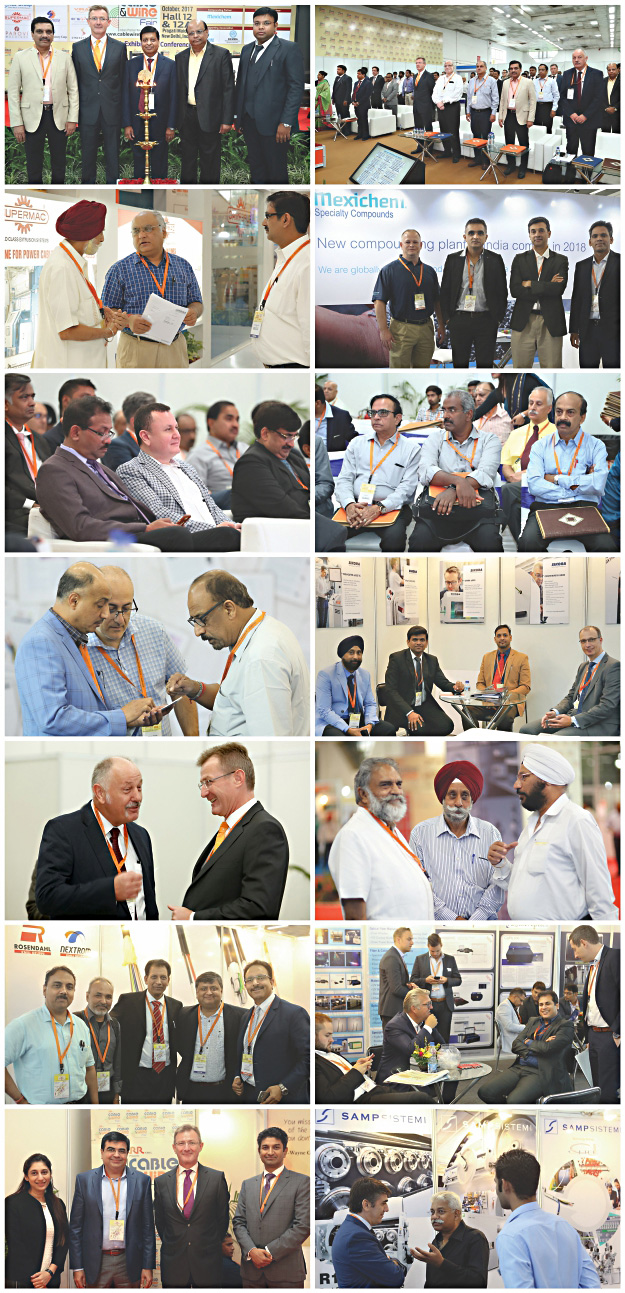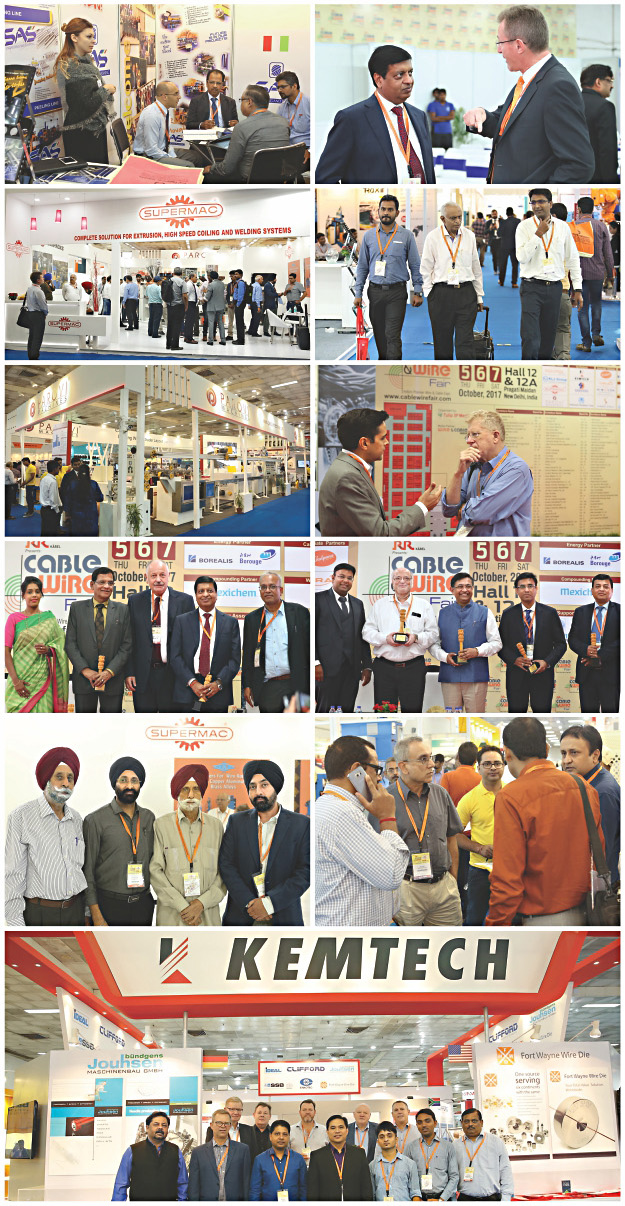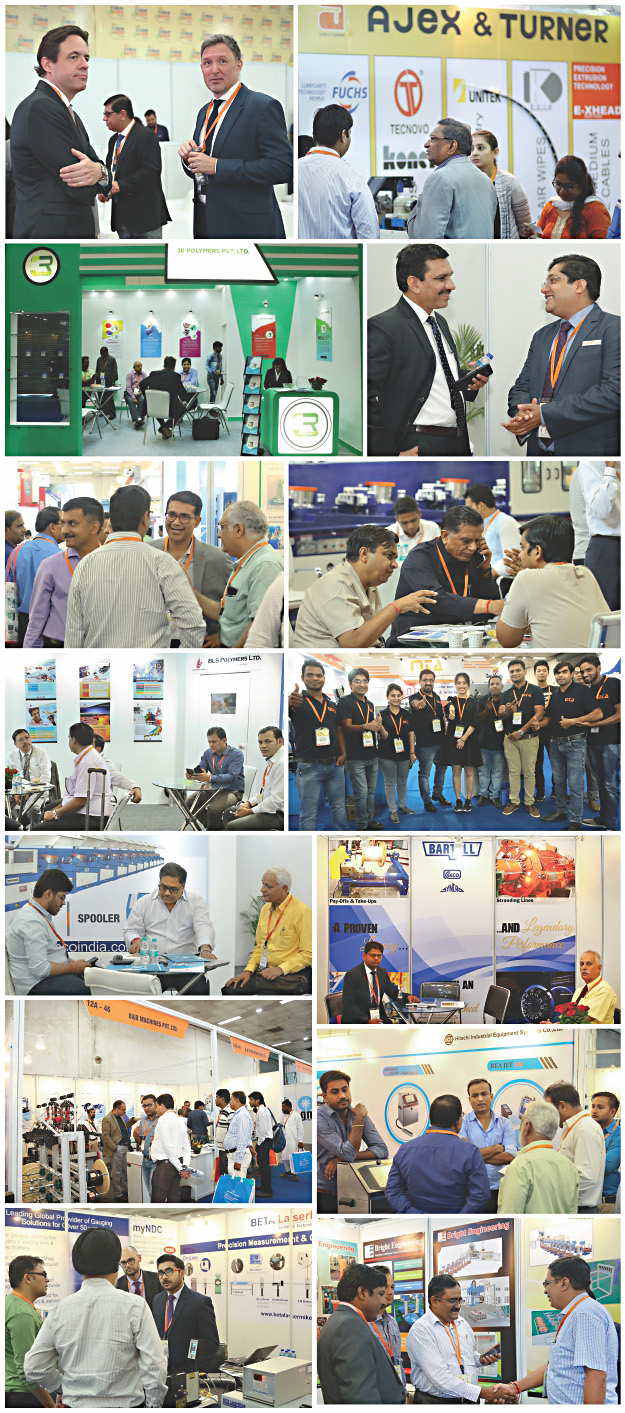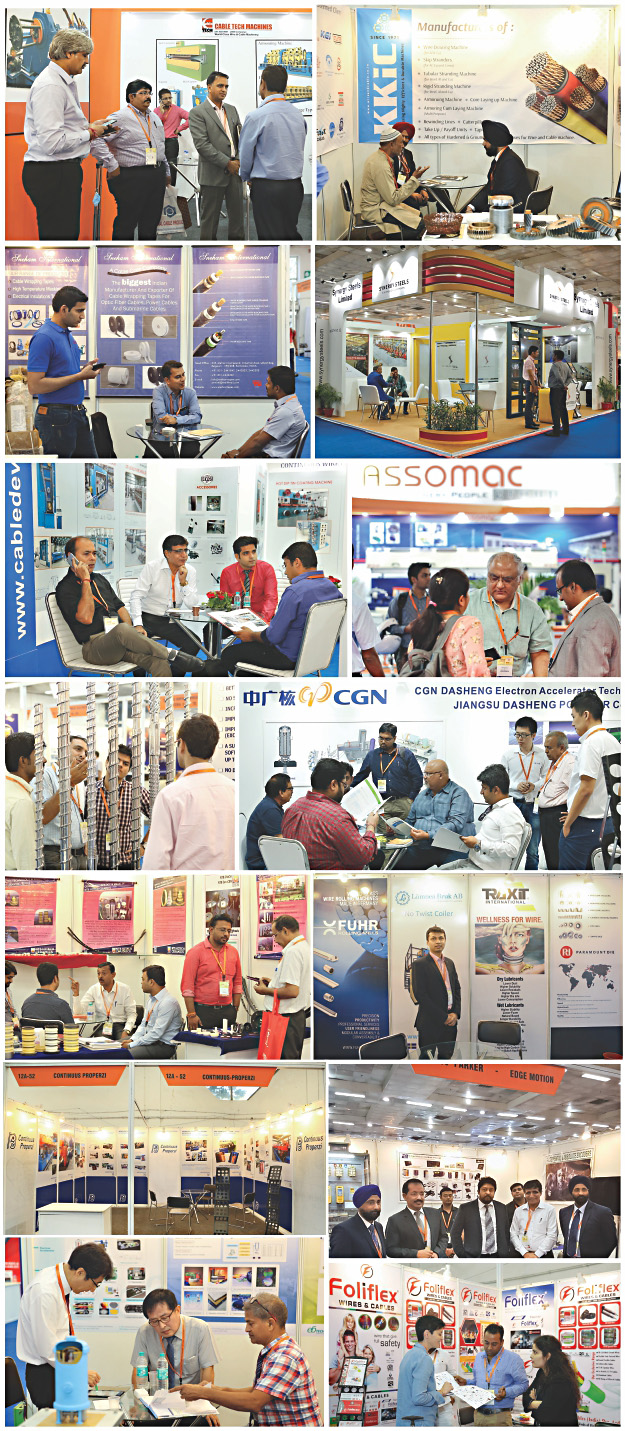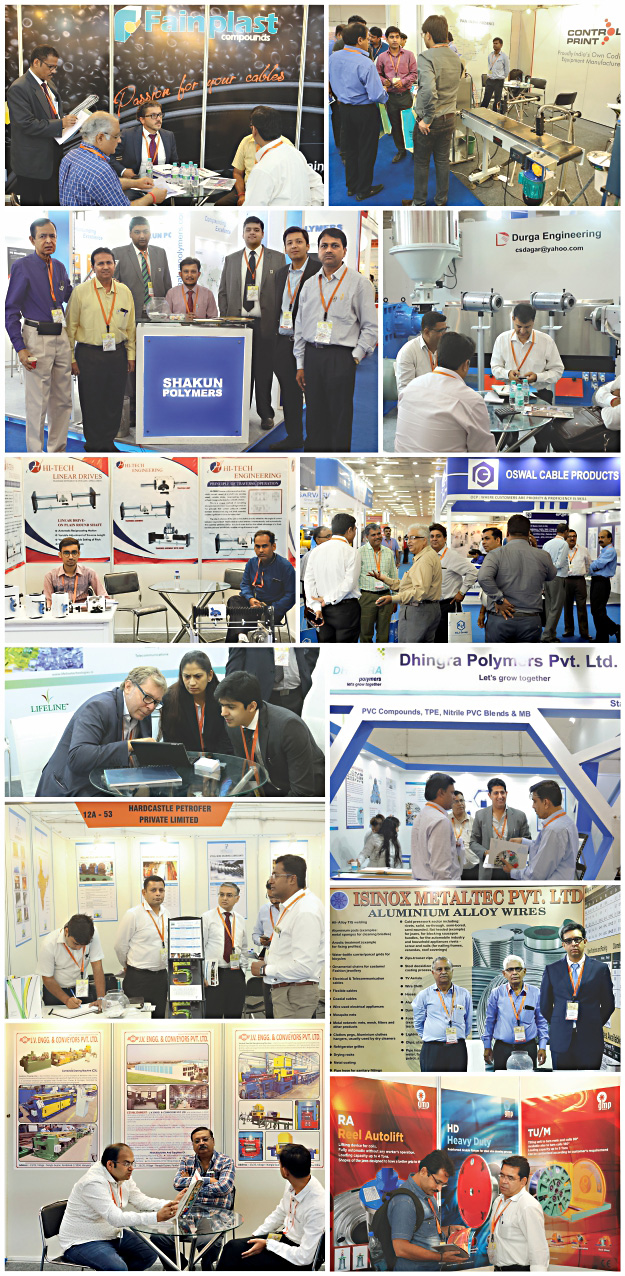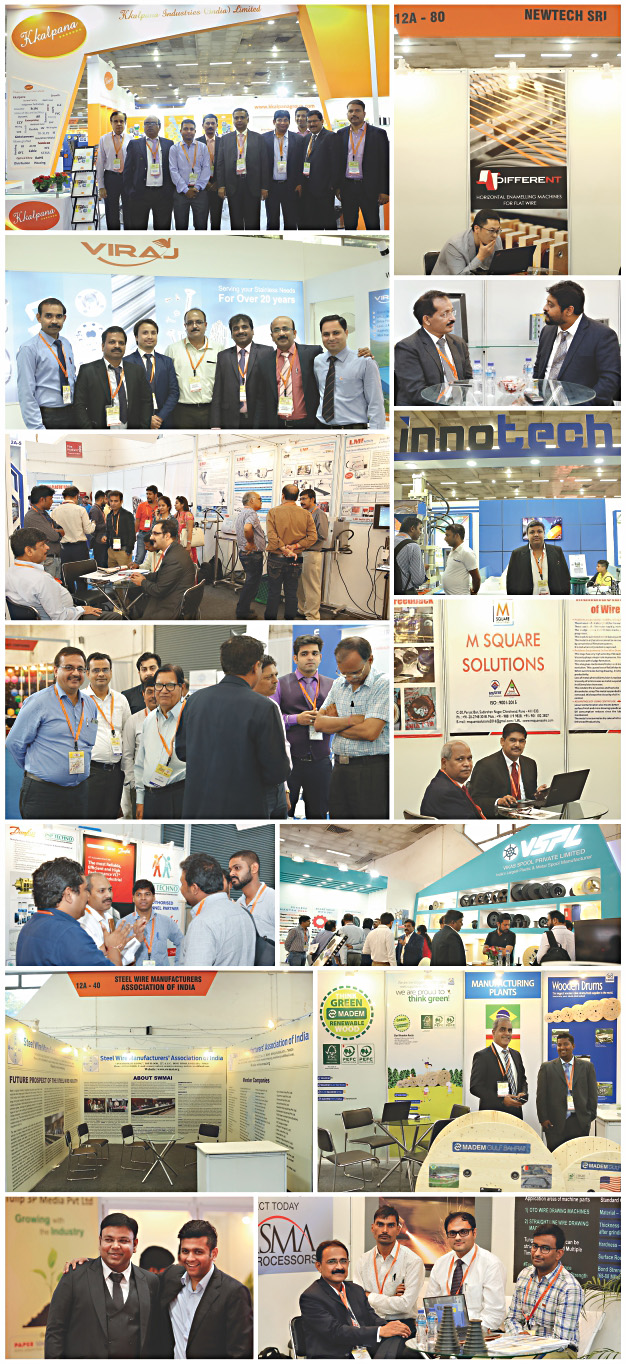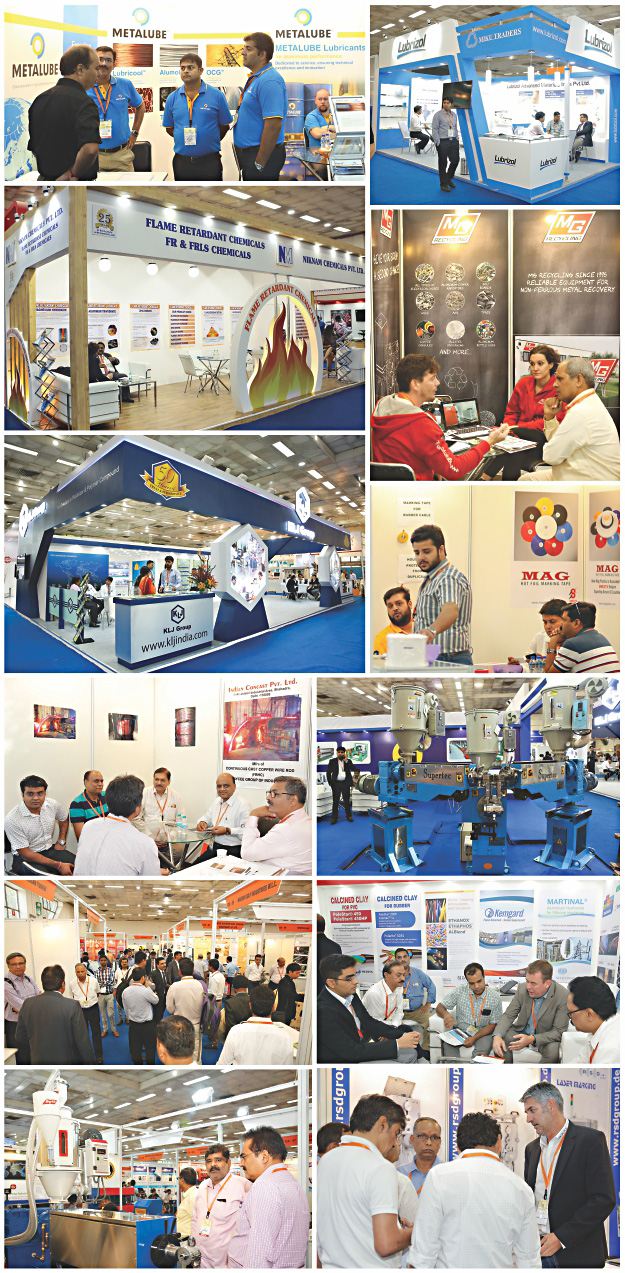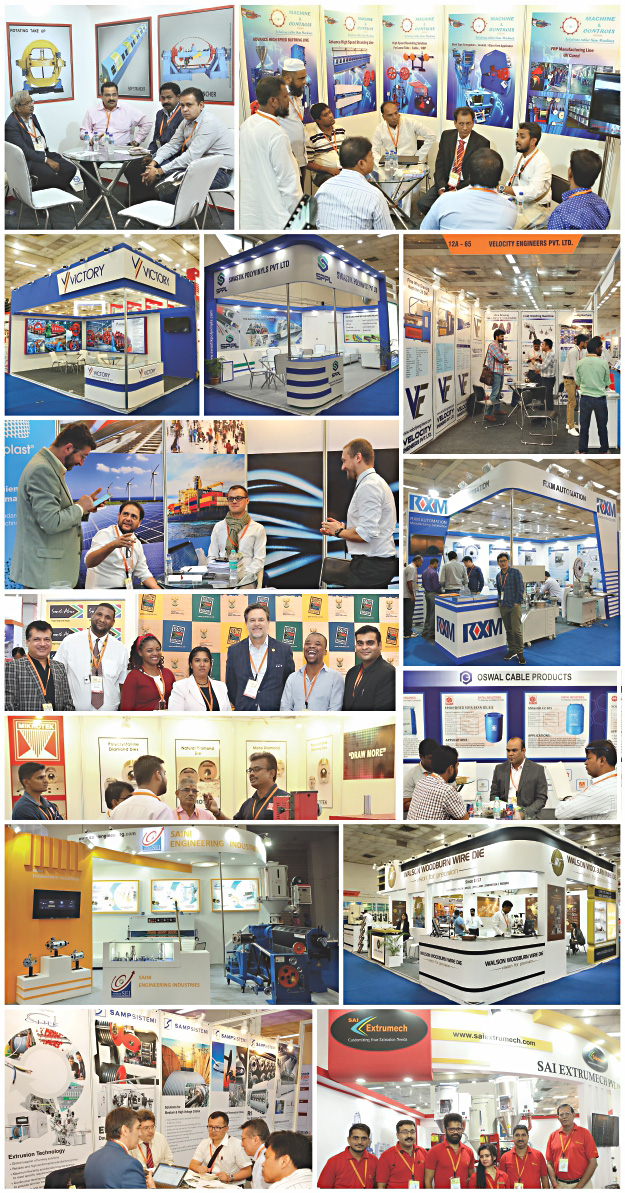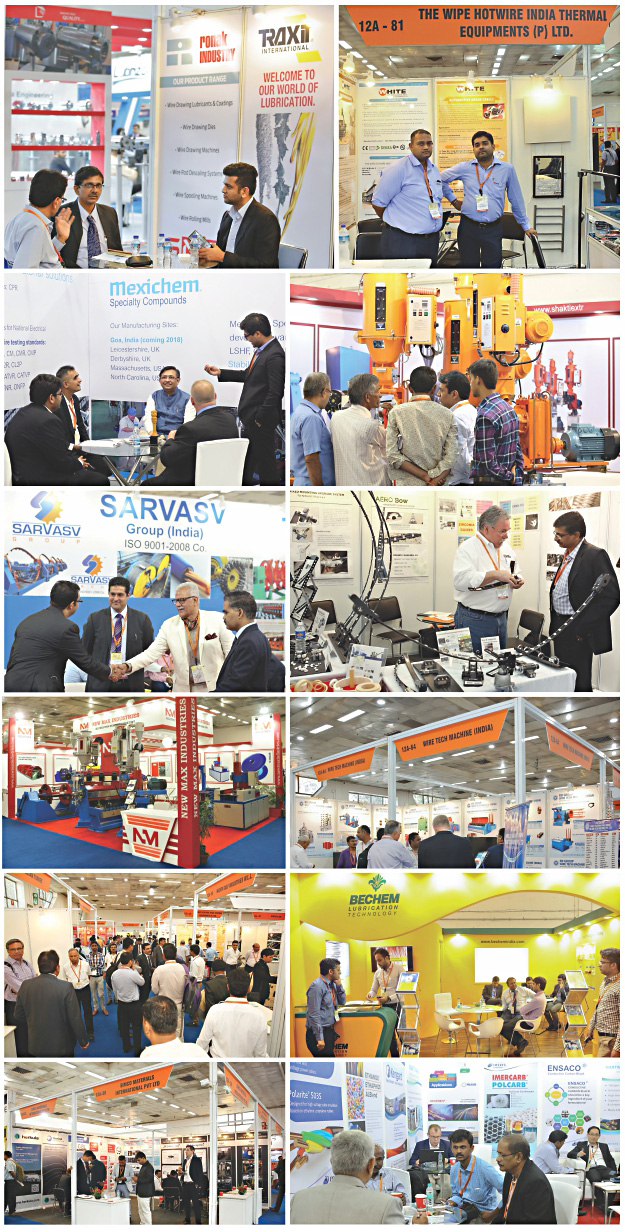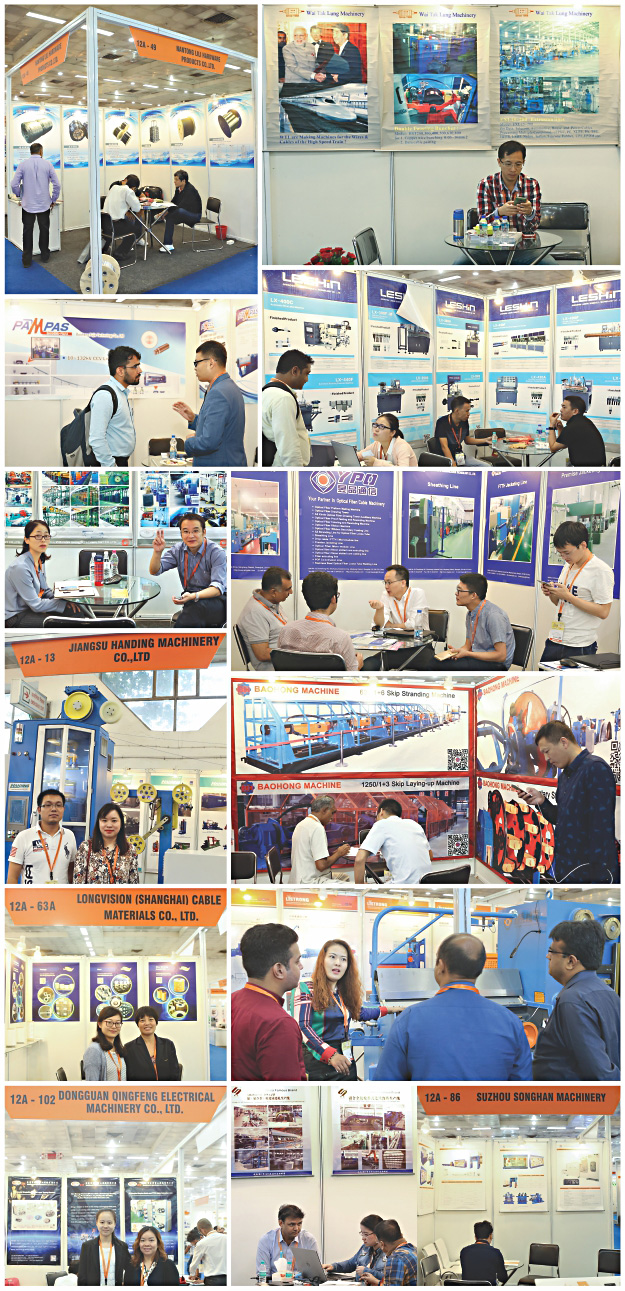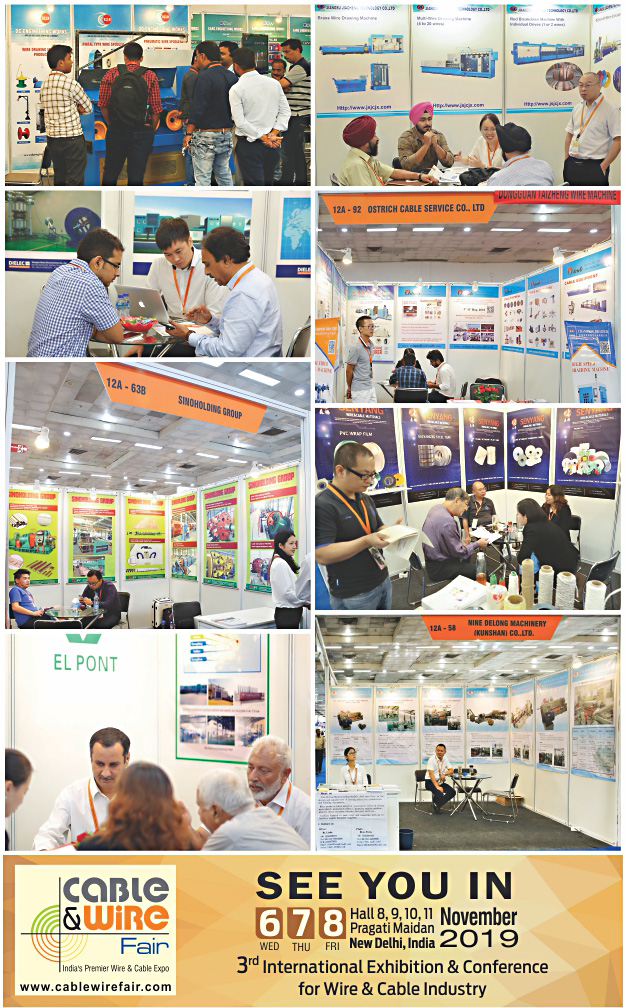With 10,800 visitors, 164 exhibitors, representation from 19 countries, and visitors from 24 countries, the premier exhibition has emerged as the undisputed centre stage of networking, information, and business for the global wire and cable industry in the heart of the Indian capital. The 2nd edition of the show has just upped every benchmark of how a B2B show should be held. Let’s have a brief review of the show!
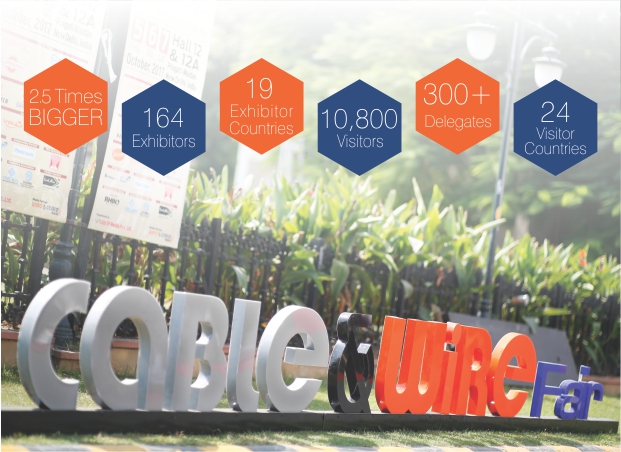 After the broader acceptance of the 1st edition, not only the spirit to go ahead with the next edition was high, but the expectations too were enormous, which made the organizers tightrope walk in order to deliver what is expected. The show largely became synonymous with business-cum-information scaffold for the wire and cable industry by combining a parallel conference with an exhibition, and the 2nd edition only made it larger in the expanse and reach (almost 2.5 time bigger than first edition), by pulling over 300 delegates, 10,800 visitors, and 164 exhibitors, all satisfied with their performance at the conference and show, which validates the performance of the show per se. The list of countries from where visitors poured in include Angola, Australia, Bangladesh, Bhutan, China, Ghana, India, Indonesia, Japan, Kuwait, Maldives, Mozam-bique, Nepal, Oman, Saudi Arabia, Singapore, South Africa, Sri Lanka, Switzerland, Thailand, UAE, Uganda, Vietnam, and Zambia.
After the broader acceptance of the 1st edition, not only the spirit to go ahead with the next edition was high, but the expectations too were enormous, which made the organizers tightrope walk in order to deliver what is expected. The show largely became synonymous with business-cum-information scaffold for the wire and cable industry by combining a parallel conference with an exhibition, and the 2nd edition only made it larger in the expanse and reach (almost 2.5 time bigger than first edition), by pulling over 300 delegates, 10,800 visitors, and 164 exhibitors, all satisfied with their performance at the conference and show, which validates the performance of the show per se. The list of countries from where visitors poured in include Angola, Australia, Bangladesh, Bhutan, China, Ghana, India, Indonesia, Japan, Kuwait, Maldives, Mozam-bique, Nepal, Oman, Saudi Arabia, Singapore, South Africa, Sri Lanka, Switzerland, Thailand, UAE, Uganda, Vietnam, and Zambia.
The organizers made an enormous effort at recording an exhaustive quantum of feedback, where a crew of cameramen, reporters and correspondents made it sure not to leave any exhibitors without expressing their experiences at the show. The level of satisfaction in terms of immaculate organization and turn out of relevant visitors at stalls was enormous, as expressed by majority exhibitors. As felt by everyone, the show proved to be an efficient platform to find business, promote products, make the brand visible, and the meet otherwise inaccessible part of the industry.
Apart from a well-arranged exhibition, the conference was studded with cable conclaves, CEO panel discussions, and technical sessions besides an elaborate inaugural session breaking the ice for 3-day mega show. The inaugural session seized the audience attention with the presence of people like Mr. Anil Gupta, CMD, KEI Industries Ltd; Mr. Andrew Shaw, MD, Dubai Cable Company (Ducab); Mr. Shreegopal Kabra, President, IEEMA and MD, RR Kabel Ltd.; and Mr. Vijay Vedmutha, MD, Bedmutha Industries, who all shared their views on various aspects of the wire and cable industry.
Capturing the Business Fabric of Wire & Cable Industry
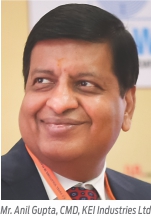 Mr. Anil Gupta, in his inaugural address, began by praising the show and how it has been able to successfully capture the entire business fabric of wire and cable industry along with its overall positivity. He said the industry has become very large and relatively consolidated over the last 10 years. “The estimated size of the industry is around Rs. 40,000 Cr growing at CAGR of around 15 percent,” he added.
Mr. Anil Gupta, in his inaugural address, began by praising the show and how it has been able to successfully capture the entire business fabric of wire and cable industry along with its overall positivity. He said the industry has become very large and relatively consolidated over the last 10 years. “The estimated size of the industry is around Rs. 40,000 Cr growing at CAGR of around 15 percent,” he added.
Emphasizing that wires and cables would remain indispensable in future, Mr. Gupta sounded confident of the sector’s growth riding on growing economy and large infra investments in times to come. According to him, the quality and technological aspects must not be undermined even if it’s (wires and cables) largely a volume-driven industry. The movement towards becoming organized has of late enhanced the quality quotient of the industry. “I think the unorganized sector now just forms maximum 10-15 percent of the industry size and the organized sector is predominantly prospering,” added Mr. Gupta.
Mr. Gupta highlighted the renewable sector’s growth spawning newer opportunities for the wire and cable industry. Wind and solar projects are installed in such remote locations where power evacuation by way of existing power transmission lines is not possible, and hence requirement for dedicated lines for such projects is immense. Apart from specialized power cable for solar and wind energy, there is major investment opportunities in LT, HT, medium voltage, and XLPE cables, he added. “The transmission and distribution side of the industry gives immense opportunities to the cable and wire industry, especially the power sector transmission,” he said. “Furthermore, the infrastructure sectors like railway, which is a key sector, has seen tremendous growth in the capital expenditure by the Govt. and will continue to see growth in the coming years. The railway sector requires almost all types of cable – power cables, railway signaling cables, axle counter cables, and so on.”
Mr. Gupta also outlined that much of the growth of the industry might be coming from booming metro rail projects in various sectors apart from the construction sector, which would surely see a rising growth curve in times to come.
On the various challenges faced by the industry, Mr. Gupta counted the recent GST regulation, which has annexed the wire and cable industry under the highest tax slab, viz. @28 percent. “Being an essential part of the economy, our industry must not vulnerable to this kind of treatment. Our association has represented to the Govt., and I have said this in various forums that we have to be given a fair treatment in terms of taxes because the levy of such high tax rate has contributed to a steep hike in our working capital requirements. We know this product is very competitive and such high tax is unnecessarily blocking our working capital and we are gaining nothing out of this tax. The tax has to be paid today and customers pay you after 60 or 90 days. This is a key challenge that our industry is facing today.”
GCC Cable Market Scenario: A Lesson for India
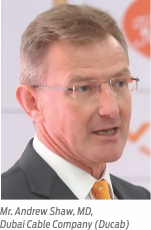 Mr. Andrew Shaw, MD, Ducab gave a detailed overview of GCC cable market in his key note address and outlined how GCC and India both can learn from each other in order to sustain a desirable growth of the industry. Mr. Shaw in his address mentioned many challenges that the Middle East cable industry, including GCC, is facing with a very low growth rate. He however sounded optimistic about few changes happening in the region, especially Saudi Arabia. “The standout for the GCC is the new changes taking place in Saudi Arabia, and if the fundamentals get changed, I believe it will change the market dynamics in the GCC and may unleash countries with 30 million people and tremendous resources, which at the moment is really held back.”
Mr. Andrew Shaw, MD, Ducab gave a detailed overview of GCC cable market in his key note address and outlined how GCC and India both can learn from each other in order to sustain a desirable growth of the industry. Mr. Shaw in his address mentioned many challenges that the Middle East cable industry, including GCC, is facing with a very low growth rate. He however sounded optimistic about few changes happening in the region, especially Saudi Arabia. “The standout for the GCC is the new changes taking place in Saudi Arabia, and if the fundamentals get changed, I believe it will change the market dynamics in the GCC and may unleash countries with 30 million people and tremendous resources, which at the moment is really held back.”
Mr. Shaw reasoned about how falling oil prices are having cascading effect of industrial degrowth across various sectors in GCC region, including wires and cables. “The bad news is that the oil price remains at about USD 50, so the budget deficit, which of course restrains spending and less spending hampers cable demand, making the cable makers upset in return.” He also highlighted how this curb on spending disturbed the project market worth USD 170 billion across GCC by a flight of USD 50 billion out of this. “The problem is we all built capacities to fund projects worth USD 170 billion,” he added. Mr. Shaw said that the GCC markets are either static or more likely most of the markets are declining. There is over-capacity and because of that the pressures on the margins are growing.
Commenting on where GCC market stands today in comparison with the world, Mr. Shaw said, “The market has really been flat since 2007-08 onwards. Since then we have bumbled along sideways. What surprises me that growth in the rest of the world cable market has been robust. Of course, India is a big part of this world market growth. The GCC is around 5 percent, which is a significant market but not huge. In GCC, we have Saudi Arabia as the biggest market and producer. The real GDP is estimated at 0.4 percent this year because first two quarters were actually into recession. But there is a lot of cable capacity in Saudi, likewise in UAE, Oman, Kuwait, and Qatar.”
Mr. Shaw also spoke about various renewable energy targets in different GCC countries and how it will cause additional demands for wires and cables. He however added that benefits are to be accrued in long term and that the GCC market seeks respite in short-term.
Outlining the significance of huge and fast growing Indian market, Mr. Shaw said, “Africa is the future but it doesn’t use much cable yet and it is fragmented into at least 52 markets. Yes, it is coming up but a very difficult place to go and find the significant volume. The Indian industry is quite successful. Therefore, the GCC looks towards India – 1.8 billion people and cables growing at 15 percent compound growth rate. There is huge potential but again, difficult for outsiders to get in.”
He also forewarned the Indian cable industry about increased Chinese imports into the country in times to come. “China is building its ‘One Belt One Road Project’. It would bring a secure logistic corridor directly from China through Pakistan to the Indian Ocean, which has implications for the Indians as well as the GCC markets. Some would say marvelous cheap products. I think we need to recognize these threats, but for sure there are opportunities for India and the GCC cable industries to work together.”
“Speaking from one formally high growth market to one currently high growth market, I think there are some learning points we can get from each other. One of them is the danger of overcapacity. I know growing demand leads to capacity and I know how quickly just a little capacity can become an awful lot of too much capacity,” Mr. Shaw said.
Steel Wire Demand Needs to Pick up
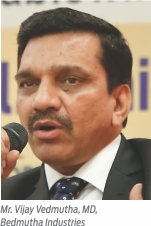 Representing the Indian steel wire industry, Mr. Vijay Vedmutha said, “We as an industry are facing the problems of slow growth and weak investments in the infrastructure sector. We are eagerly looking toward to faster growth and good investments.”
Representing the Indian steel wire industry, Mr. Vijay Vedmutha said, “We as an industry are facing the problems of slow growth and weak investments in the infrastructure sector. We are eagerly looking toward to faster growth and good investments.”
Mr. Vedmutha also expressed that the Indian steel wire industry is passing through margin pressures because of the over-capacities in the industries and it is mostly because the demands are on a lower side than expected. He attributed this over-capacity to continuous capacity addition by the industry in hope that the infra sector would see larger investments and huge capacities would be required to cater the demand. “The investment is happening but only slowly. I am hopeful it will definitely take place in the near future,” he added.
As per Mr. Vedmutha, the Indian steel wire industry today is at par with the world industry as far as speeds and processes are concerned. “We used to have problems with availability of quality wire rods, but that is now available in the country. The only requirement for now is that demand should pick up as fast as it can and the end user needs to be made aware of the quality parameters,” he explained.
Mr. Vedmutha sounded really happy for the organization of the exhibition-cum-show and congratulated Tulip 3P Media for organizing the international level exhibition.
Quality, the Ultimate Benchmark for the Industry
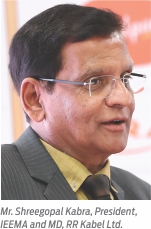 In his special address, Mr. Shreegopal Kabra, continuously prodded the idea of ‘good quality’ in both production and consumption processes. He threaded together the industry’s sustainable growth with quality control in his eloquent speech and emphasized that quality has to be constant growth partner of the industry. “I am not at all doubtful about the growth of the wire and cable industry. The question is how the growth will occur and whose growth it will be – the organized players or the unorganized ones, he said. Mr. Kabra was of opinion that unorganized sector had always been a cause of an unhealthy competition to the organized sector and quality always suffers in the process.
In his special address, Mr. Shreegopal Kabra, continuously prodded the idea of ‘good quality’ in both production and consumption processes. He threaded together the industry’s sustainable growth with quality control in his eloquent speech and emphasized that quality has to be constant growth partner of the industry. “I am not at all doubtful about the growth of the wire and cable industry. The question is how the growth will occur and whose growth it will be – the organized players or the unorganized ones, he said. Mr. Kabra was of opinion that unorganized sector had always been a cause of an unhealthy competition to the organized sector and quality always suffers in the process.
Mr. Kabra also highlighted the issue of electrical safety of wires and cables by saying that maximum number of fire accidents is electrical in nature and 60-70 percent are due to faults in wires and cables. “Being a sensitive commercial sector, the wire and cable industry needs to be well taken care of. Moreover, if we work together unanimously as cable manufacturers, we can improve the standard of wire and cable,” he added.
“BIS does not have the complete certification repertoire on various much needed cable and polymer standards. We at RR Kabel are making wires for last 19 years and we are the first company to make LSZH cables and BIS still don’t have the facility to give BIS mark. We are the first one to start HR PVC. We have to reduce and then come back to non-HR PVC because BIS does not approve that,” added Mr. Kabra.
Mr. Kabra also raised the issue of falling qualities of the solar cables with falling of prices. “The kind of quality these solar projects are using, I doubt whether it will work for 25 years. Because of the inferior quality of solar cables, the output of solar power will definitely go down after five or seven years,” he added.
Mr. Kabra also suggested that the Govt. and public sector procurement policies should shift its focus from L1 to Q1 and quality should get precedence over price. “The mood of the Govt. of various countries is toward L1. In my opinion, L1 is the biggest disaster. And, we as a manufacturer should not fight for L1. We should fight for Q1. How long can we fight for L1? Is it possible that good and cheap can work together? I doubt. If it is a really good quality wire, it cannot be the cheapest. We need to have some premium over there,” he said. “’Make in India’ will be successful when we all will make a good quality product, sell good quality product and use a good quality product. Otherwise, it might remain as a slogan.”
“People are looking towards India as a reliable supplier. In last 3-4 years, our Indian brands have grown to a different level. Last month, I was elected as an IEEMA President. From IEEMA platform, we have taken this vision that electrical safety is the first. In future, if we don’t do investments, I don’t think we will be able to improve quality. As a cable manufacturer, it’s our social and moral responsibility to make the safest cable because we should not play with human life,” Mr. Kabra concluded.
Cable Conclaves, CEO Discussions and Technical Sessions
CWF17 saw some high-voltage discussions at its cable conclaves and CEO discussions wherein a myriad of issues pertaining to cable industry were raised and discussed. Besides, technical sessions provided much needed space to industry experts to present some of the much talked about themes of wire and cable technology. In all, two cables conclaves, two CEO panel discussions, and two technical sessions were organized to give ample time to capture both business and technology side of the industry.
 In first cable conclave the likes of Mr. Anil Gupta, CMD, KEI Industries Ltd; Mr. Tony Martens, VP, Technology and Development, Polycab Wires Pvt Ltd; Mr. Shreegopal Kabra, President, IEEMA and MD, RR Kabel Ltd. presented their views on various topics such as quality, pricing, standardization, govt. regulation, and taxation. While in the second cable conclave, industry stalwarts like Mr. VK Bajaj, COO, Uniflex Cables Ltd; Mr. Abhishek Gupta, Director, Gupta Power Infrastructure Ltd; Mr. Sandeep Aggarwal, MD, Paramount Communications Ltd; and Mr. Sanjeev Ranjan, MD, International Copper Association India presented their perspectives from different product segment of the industry, viz. power cable, telecom cable, copper wire, etc.
In first cable conclave the likes of Mr. Anil Gupta, CMD, KEI Industries Ltd; Mr. Tony Martens, VP, Technology and Development, Polycab Wires Pvt Ltd; Mr. Shreegopal Kabra, President, IEEMA and MD, RR Kabel Ltd. presented their views on various topics such as quality, pricing, standardization, govt. regulation, and taxation. While in the second cable conclave, industry stalwarts like Mr. VK Bajaj, COO, Uniflex Cables Ltd; Mr. Abhishek Gupta, Director, Gupta Power Infrastructure Ltd; Mr. Sandeep Aggarwal, MD, Paramount Communications Ltd; and Mr. Sanjeev Ranjan, MD, International Copper Association India presented their perspectives from different product segment of the industry, viz. power cable, telecom cable, copper wire, etc.
The first technical session saw three presentations from compounding solutions companies and technology providers. Mr. Tapas Dey, Application Development Engineer, Borouge’s Energy Business Centre presented his well-conceived presentation on “Jacketing Solutions for Buried Cables”. Mr. Mark A. Jozokos, Global R&D Manager, Compounds BU / USA & UK, Vinyl Business Group, Mexichem Specialty Compounds presented to the audience a much sought after theme “Low Smoke Halogen Free Solutions in Wire & Cable”. Mr. M. Murali Das, Sales Manager, Rosendahl Nextrom Gmbh, India presented the range of technology for cable making which Rosendahl offers in the form of its highly acknowledged extrusion and stranding lines.
In the second technical session, Mr. Enrico Conte, Product Manager Metallurgy, Sampsistemi srl presented Samp’s “Modern solutions for aluminum wire and cable application”. Mr. Holger Lieder, Sales Director, SIKORA AG explained about “Online measuring and control technologies for process optimization at the production of energy cables”. Mr. B Kamal Babu, MD, Mikrotek Machines Ltd. in his power presentation talked about “Setting standards for selection of wire drawing dies and enhancing efficiency”.
A CEO panel discussion, exclusively for the Indian steel wire sector, was held at CWF17 to highlight potentials, issues, and trends in from the perspectives of major players in this important industry. The panel included Mr. Nirmal Saraf, Managing Director, Nirmal Group of Companies; Mr. Vijay Vedmutha, Managing Director, Bedmutha Industries; Mr. Sunil Chordia, Managing Director, Rajratan Global Wires Ltd; and Mr. Sampath Gilada, Director, Gilada Group of Companies. The discussion was moderated by Mr. Nirmal Singh, Director, ASSOMAC.



